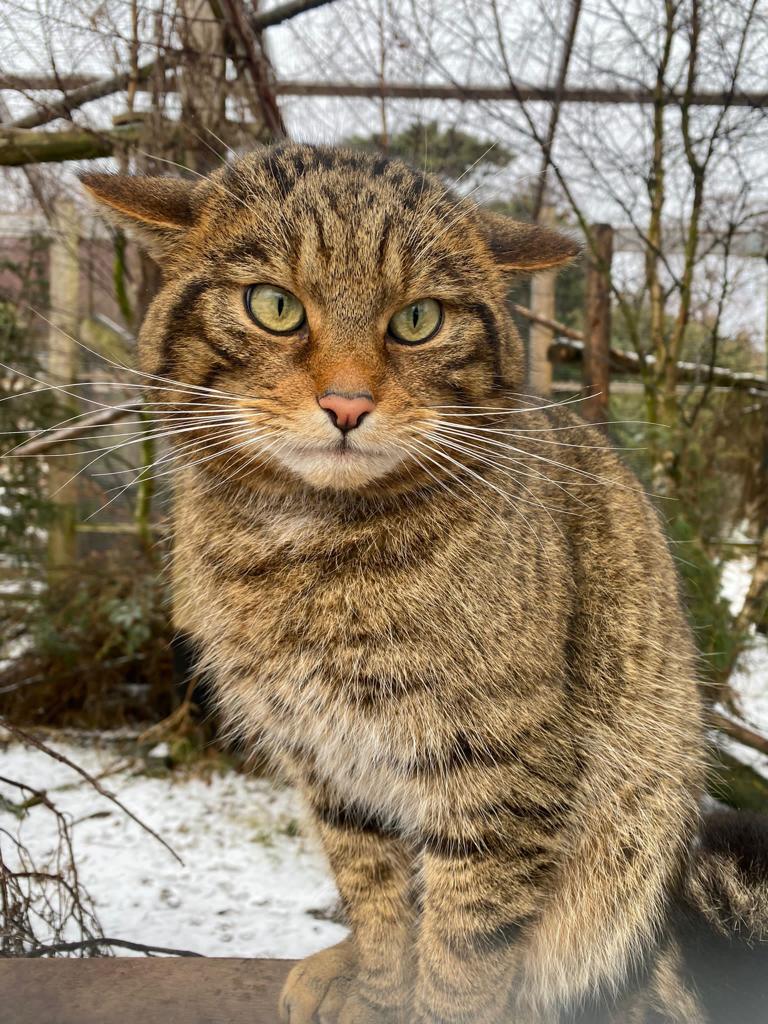Scotland’s wildcats one step closer to releases in the Cairngorms National Park later this year
24/04/2023 in RZSS

The Saving Wildcats conservation partnership project has announced that the wildcats which will be released in the Cairngorms National Park this summer moved into specially designed pre-release enclosures earlier this year.
Led by the Royal Zoological Society of Scotland (RZSS), the Saving Wildcats partnership is working to restore Scotland’s critically endangered wildcat population by breeding and releasing them into the Cairngorms Connect project area. All the cats have now been moved into large, natural pre-release enclosures that have been designed to help them prepare for the challenges of life in the wild. These new pre-release enclosures, of which there are 20, were constructed in 2022 as a core element to the project’s dedicated wildcat conservation breeding for release centre based at Highland Wildlife Park.
David Barclay, Saving Wildcats ex-situ conservation manager, said “It is fantastic to have passed this critical milestone in the project and exciting to take another important step forward in the plans to release wildcats this year. The journey to restore a viable wildcat population in Scotland is just beginning and we are incredibly grateful for the efforts of our team members, partners and supporters whose expertise has been crucial to reach this point.”
The pre-release enclosures situated in the eight-acre conservation breeding for release centre at Highland Wildlife Park are managed in a way which supports natural development and reduces exposure to humans and disturbance. They are not available for public viewing.
Mr Barclay continued “The large pre-release enclosures are designed to encourage the cats to exhibit their full repertoire of natural behaviours whilst promoting social interactions and communication between cats. Our expert keeper team also use a selection of tools and techniques to promote natural activity patterns whilst enhancing key skills needed for life in the wild, including hunting, foraging and scent marking. To compliment this, we have an extensive CCTV system which allows us to monitor the behaviour of the cats around the clock from our office, without any activity at the enclosures.”
A second breeding season has also begun ahead of next year’s releases with pairs Fruin and Beanie, Fian and Rannoch, Cranachan and Margaret, Torr and Embo, Droma and Arran, Oscar and Caol Ila and Nell and Con. Male wildcat Ordie is patiently awaiting the arrival of another female wildcat as partner Tulla sadly died from complications following a fractured leg, despite the best efforts from our experienced veterinary team. Rannoch's last partner Fearn moved to Golders Hill Park Zoo in London.
This week, supporters of the Saving Wildcats project can make their donation go further by donating through the Big Give Green Match Fund. All donations made during the week of 20 – 27 April up to a total of £10,000 will be matched.
Saving Wildcats is led by the Royal Zoological Society of Scotland in collaboration with NatureScot, Forestry and Land Scotland, the Cairngorms National Park Authority, Norden’s Ark and Consejería de Medio Ambiente y Ordenación del Territorio de la Junta de Andalucía.
The project is funded with the contribution of the LIFE Programme of the European Union and the generous support of the Garfield Weston Foundation, the National Trust for Scotland, the People’s Trust for Endangered Species, the European Nature Trust and the Scottish Government.
The pre-release enclosures were built with the support of the Cairngorms National Park volunteer programme, Chester Zoo, Forestry and Land Scotland, University of St Andrew’s School of Psychology and Neuroscience and experts and advisors including Consejería de Medio Ambiente y Ordenación del Territorio de la Junta de Andalucía.
[ENDS]
Notes to editors:
- Wildcats are typically solitary in the wild. The move away from parents and into these pre-release enclosures mimics the natural dispersal age of wildcats.
- Although similar in size, the European wildcat (Felis silvestris) is a separate species to the domestic cat (Felis catus). Their habitat preference is a mosaic of mixed forests and grassland habitats and their preferred prey is rabbit, when available.
- NatureScot has approved a licence application from the Saving Wildcats partnership to release wildcats in the Cairngorms Connect area of Cairngorms National Park later this year: scot/first-ever-scottish-wildcat-release-approved
- The cats being released were born in the Saving Wildcats conservation breeding for release centre, based in Highland Wildlife Park, in 2022: org.uk/media-centre/article/21128/hugely-successful-first-breeding-season-at-saving-wildcats-conservation-breeding-for-release-centre/
- The project’s wildcat conservation breeding for release centre is the first of its kind in the UK and follows other similar dedicated endangered species breeding centres including Iberian lynx and European mink.
- Cairngorms Connect is a partnership of neighbouring land managers (Wildland Limited, Forestry and Land Scotland, RSPB Scotland and NatureScot) working towards a 200-year vision to enhance habitat, species and ecological process across a vast 600 square kilometre area within the Cairngorms National Park. It is the largest habitat restoration project in the UK and is funded by the Endangered Landscapes Programme.
- For more information visit org.uk
Images and video
- Images are available at the following Dropbox link: com/scl/fo/pw0asttsqir3z310xldqg/h?dl=0&rlkey=73i90e55anymxoej2dbnccypu
Images are free to use but please credit RZSS/Saving Wildcats
About Saving Wildcats (#SWAforLIFE)
- Saving Wildcats (#SWAforLife) is a European partnership project dedicated to Scottish wildcat conservation and recovery. We aim to prevent the extinction of wildcats in Scotland by breeding and releasing them into the wild
For further information, please contact comms@rzss.org.uk
Featured Articles

An update from the Budongo Forest
19/04/2024 in Conservation

Edinburgh Zoo named best zoo in Scotland
15/04/2024 in Edinburgh Zoo

























Follow EZ